

COMPOSTING FOR HEALTHY SOIL & HIGH-QUALITY FOOD
By: Caver
"Feed the soil, not the plant", is the battle cry of many an organic gardener, because they know that healthy, living soil will give the plant everything it needs. Composting, which is man's system of managing and speeding up nature's process of decay, is the most time-proven way to build this living soil. Finished compost is free of pests, disease and seeds because of the purification process it goes through. It is light & fluffy with high water retention qualities, and has a wide variety of nutrients that are extremely bio-available to the plants root systems. Since most of us have a steady stream of organic waste from our meals, grass clippings, and other yard or animal wastes, we can also have a constant supply of compost.
You may ask why go through all this work when you can just go out and buy a bag of fertilizer, dump it on and presto---easy veggies. Studies have shown that in less than 100 years of chemical farming, our soils are deficient in many crucial minerals like selenium---known to boost our immune system and regulate heart functions. Our foods in the supermarket, also analyzed, are believed to contain about 10-20% of the nutrition of those grown organically 50 years ago. It may be no wonder why cancers and other diseases are in epidemic proportions in the U.S. today. We may be literally starving ourselves with empty foods, while being exposed to an ever-increasing amount of chemicals in today's environment. Making compost out of your clean yard and kitchen wastes can improve your garden soil and insure that your plants are nutrient rich and chemical free.
Living soil is the key to high-quality nutrition
The reason that composting creates a fertilizer that is superior to chemical fertilizers, is because the process allows various microorganisms, beneficial insects and finally earthworms to completely digest the plant matter and create a final product that is more absorbable by the plants roots. This secondary digestion happens after the compost pile has first heated up to 180 degrees from microbial action (fungi and bacteria). This initial heating process destroys all pathogens and pests, then other beneficial insects and earthworm finish the compost pile you have built . You are finally left with a moist pile of fluffy brown soil that's alive with the proper balance of nutrition and critters. This soil will then grow clean, energizing food for you and your family.
The Composting Process
You first need to find a place to build your compost pile, preferably away from the front and back doors of your home. After you've found a good location, you can use several different materials to contain your pile. I've used CBS blocks, wood frame, even chicken wire to enclose my compost piles. I've also used nothing and let a pile sit out in the yard until ready to use. In photo 1, you will see our current pile is made from pallets. We had a free and easy source for them so we just nailed them together on 3 sides and made a 3-bin composter.

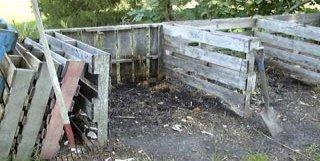
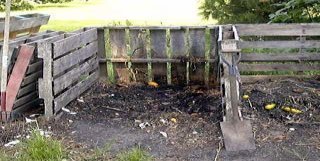
Next, you need to have a good mixture of carbon-rich materials like dry leaves or straw, and nitrogen-rich matter like green grass clippings, kitchen scraps, or manure. One study I read said 5 parts brown (carbon) to 1 part green (nitrogen) is the best mix. We don't worry too much about this because we do a simple layering technique which is quick and efficient, and more or less gets everything needed into the mix. As you can see in photo 2, I have put on a layer of brown, then green and so on. Water each layer sufficiently as you build up to give it a spongy wet consistency. A good, active compost pile should be at least 2x2x2', with 3 or 4' across piles being even better. You then let the pile "cook" for 3 days or so---it will sometimes even steam. (A note here: you can actually heat up your pile too much and kill the entire colony of beneficial microbes by adding too much green (nitrogen) material. Never exceed 1 part green to 1 part brown matter). After the initial 3 day cook, you need to turn the pile and water it because it will have exhausted its supply of air and moisture. It will then go on cooking but the reaction will begin cooling down in another couple days. Keep turning the pile every few days because remember, composting is an aerobic (with air) process, and all the beneficial critters need the air to continue their work.
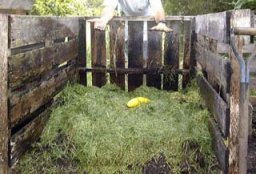
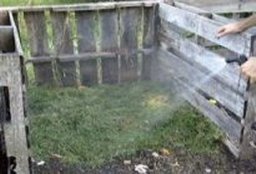
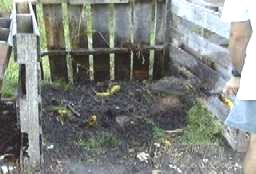

Don't worry about making your pile high because it will shrink down to less than half its original size after the process is completed. You will know when it's ready because it will look like the richest dark, fluffy soil you have seen. It will also be cool. If you still feel heat it is NOT done and should be allowed to finish properly. Also, and this is very important---NEVER put fresh green clippings around a plant. As it breaks down it needs nitrogen and will literally rob it from your plant to complete its job. A finished compost pile should have few large or recognizable pieces of food left---just beautiful brown soil crawling with earthworms.

Don't worry if you don't have earthworms right away. In some locales, they were never establishged due to poor soils, lack of moisture, etc. You can always go to a bait and tackle shop and get either black earthworms or red wigglers and seed your pile, they both do fine. I personally like regular earthworms because they seem stronger during the dry times we have here in N. Florida. Oh, BTW, you don't see any finished compost in my piles cause I use it so quickly it never stays around. It truly is "Black Gold". Happy harvesting all.